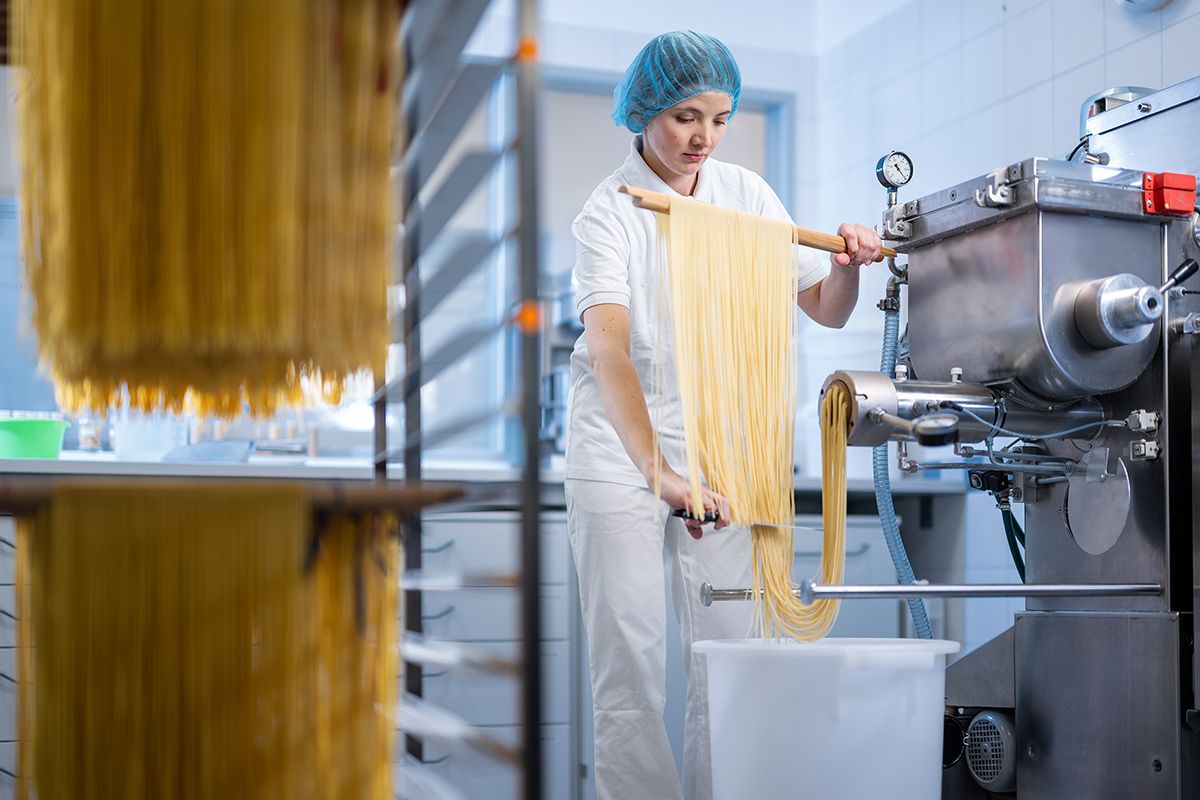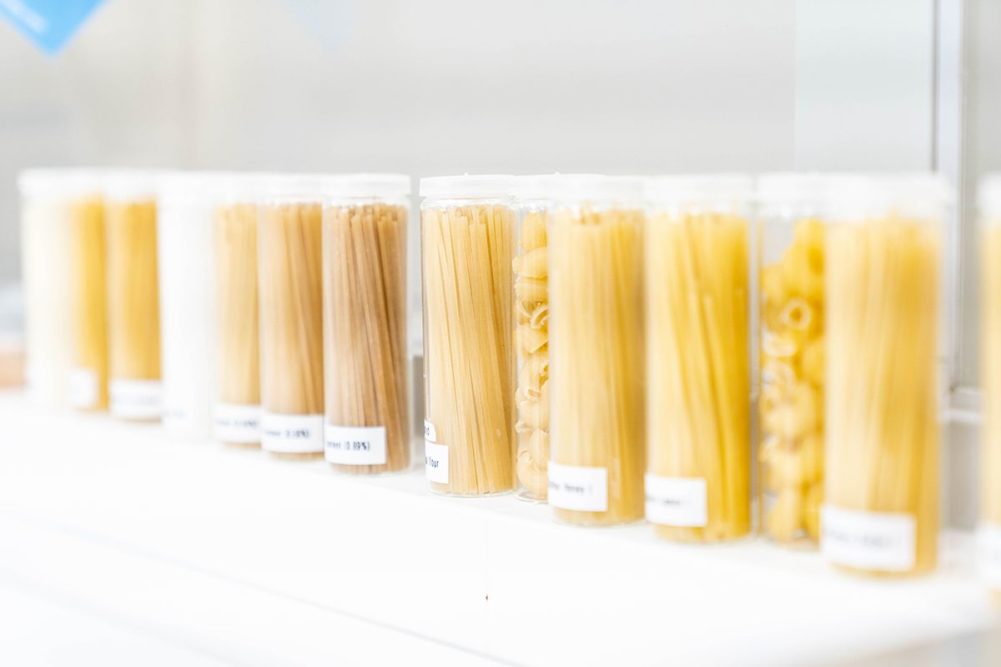Flour or semolina and water – two ingredients, more than 350 varieties. That’s the grand total for pasta, a beloved favourite around the world. But manufacturers know that making spaghetti and the other pasta varieties is a complex, challenging task. This is especially the case for pasta makers in Africa and Latin America. Difficult conditions like varying raw material quality, uncertain supplies, and high cost pressure make it a difficult business that demands flexibility. The use of cheaper bread wheat (Triticum aestivum) instead of the Triticum durum normally used for pasta is a common solution. There is also more and more experimentation with local grains like millet and maize.
“Unfortunately theoretical approaches cannot simply be applied to the available production equipment. Trials at industrial scale take time, have a high rate of failure and rejects, and often require large quantities of raw materials,” reports Agostino Coppola. And he should know. Not only is it part of his DNA as an Italian, but as a pasta technologist he has made his passion his profession, and is as knowledgeable about production processes and quality issues as he is about processing and equipment. This benefits the pasta producers and customers whom Agostino Coppola advises on site. The long experience of his employer MC Mühlenchemie is always part of his toolkit. Just last year this company, an international leader in flour treatment, celebrated its 100th anniversary and with it a pasta milestone.
Enzymes and technology – two sides of the same coin
In 2011 MC Mühlenchemie technologists achieved a breakthrough in the use of bread wheat. The key to success is called Pastazym. “With our tailor-made enzyme systems millers and pasta makers can compensate for deficits in their raw materials, and make high-performing pasta flours out of weak wheat varieties with low protein content. The focus is on bite, stickiness, cooking stability, cooking loss and colour intensity,” explains technologist Jana Russnak. In the company’s pasta lab she and her team simulate pasta production at small scale, including with their customers’ flours. As an experienced expert, she knows that “enzymes are just one side of the coin. The settings on the production line are equally important. Only when everything works together do manufacturers get the full economic benefits.”
When using alternative pasta flours, producers must pay especially careful attention to challenges in drying, since burnt, brittle or cracked pasta are a frequent problem and result in needlessly high reject rates. Agostino Coppola, who also has many years of experience at Italian pasta machinery maker Fava S.p.A., shows customers and their machine operators how to make the right adjustments. “Together we look at the water dosing and temperature, as well as the extrusion pressure and moisture content of the pasta products.” There are clear specifications for the latter along the different drying zones. While pasta ideally has a moisture content between 16 and 17.5 percent when it leaves the pre-dryer, it should only be 11.5 to 13 percent at the end of drying. That enables perfect results at the refrigerator output, where 12.5 percent moisture should not be exceeded. If it is higher there is a risk that cracks may appear even days after manufacture. If it is lower the pasta is more liable to burn, and can get brittle and develop cracks.
Effective regrind management
With the right drying manufacturers minimize the amount of non-saleable pasta. However, rejects cannot be entirely prevented, especially in long formats like spaghetti. In its production, cutting results in five to seven percent rejects, which can be reground and run back through the process as regrind. The expert’s advice for dependable high quality: Efficient regrind management that factors in pasta format, particle size and mixing systems.
The smaller the pasta, the higher the permissible amount of regrind – there is a simple rule for pasta formats. For long products it should be no more than eight percent. Short-cut pasta can take up to ten percent. Small soup pasta can be up to 20 or even 30 percent regrind. The recommendation for grain size is likewise simple. It should be the same as for the raw material, not more than 350 micrometres. And finally, the pasta presses with their various mixers and associated mixing times affect the way regrind integrates into the production process. An upstream conveyor belt makes it easier. “You should always use regrind with care. Too much of it, too large particle size, and too short mixing times affect dough quality negatively. And then you get the opposite effect – more rejects at the end of the process. Avoiding that is our goal,” explains Agostino Coppola, adding, “If you reduce the extrusion pressure by about 5 bar and simultaneously increase the water dosage, you’ll get better water absorption during mixing. Raising the water temperature slightly helps with the absorption process, for fewer product defects like white spots, which are caused by poorly wetted regrind particles.”

Monitoring and maintenance for top machine performance
For trouble-free manufacturing, regular checks of parameters like relative humidity and air temperature are important. Sensors can be installed at strategic points in the production line to monitor these and similar variables. They make it possible to home in on problems and solve them. For example, the hot water valves can be set to increase the circulation of hot water in the system to bring the temperature back up if it falls below the target value. The same goes for the relative humidity. If it exceeds the target level, with the right actuator settings the ratio of dry and wet air will be automatically adjusted. Regular maintenance is part of proper system operation. Routine sensor calibration and comprehensive inspection of valve and plunger functioning are just some examples of steps that save money. Maintenance extends machine life, minimizes down time, and reduces costs. And that makes not only the pasta manufacturer, but also consultant Agostino Coppola happy. “I have the opportunity to help customers in different and sometimes difficult circumstances to achieve business success. That’s very rewarding for me personally.”
MC Pasta 360° service
Raw materials and flour quality, drying and other process steps, production systems and their maintenance – all the components need to be in place for pasta manufacturing. MC Mühlenchemie assists its customers with 360° service. The team is made up of food technologists, experienced pasta production technicians, enzyme specialists and pasta lovers. They provide efficient flour improvement, the facilities of a pasta lab with pasta pilot plants and professional dryer for realistic simulations and very nearly 100 percent precision, on-site process consulting, and assistance in upscaling new formulations for industrial production. They also offer customer trainings and workshops. More information: www.muehlenchemie.com.







